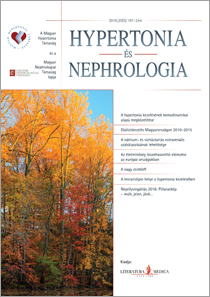The eLitMed.hu medical portal uses computer cookies for convenient operation. Detailed information can be found in the Cookie-policy.
Hypertension and nephrology - 2016;20(05)
Content
[Hemodynamic approach of the treatment of hypertension. The possible role of impedance cardiography in the tailored antihypertensive therapy]
[It is important to achieve the blood pressure targets in the course of antihipertensive therapy. It will be beneficial to increase the proportion of patients on blood pressure target to avoid adverse cardiovascular consequences. In hypertension the main definition the elevation of blood pressure alone, but in hypertension are several abnormalities of cardiac output, systemic vascular resistance, stroke volume and arterial compliance too. Impedance cardiography is a simple highly accurate non-invasive device to assess hemodynamic parameters in hypertension. Hemodynamic assessment may help in the treatment of hypertension. Various authors report the improving rate of blood control rate using impedance cardiography which may decrease the risk of target organ damage.]
[Dialysis treatment in Hungary: 2010–2015]
[The authors show the data of Hungarian dialysis statistics from 2010 to 2015. The questionnaire - based data collection was made by Dialysis Registry Committee of the Hungarian Society of Nephrology. The number of all patients entered in the dialysis program increased by 8.4% over six years (an average of 1.4/ per year) and the number of new ones increased by 10.5% (1.75% per year). Between 2003 and 2009 the mean annual increasing of new patients was 7.5%! The incidence of new dialyzed patients was 440/1 million population in 2010 and 486/1 million) in 2015. The population point prevalence at the end of the year was 621/1 million in 2010 and 643/1 million in 2015. The penetrance of peritoneal dialysis was 13.5% in 2010, and 13.6% in 2015. The proportion of incident patients with diabetic or hypertensive nephropathies (conditions which lead to end stage renal disease) was about the same in 2010 (27 and 21%) than in 2016 (27 and 22%). The mean age of incident patients entered into dialysis program decreased from 66.9 years (2010) to 62.8 years (2015), surprisingly. The rate of patients on waiting list for renal transplantation was 10.7% in 2009 and increased to 15,8% in 2015. There is also a significant increase in the number of the annual renal transplantations (268 in 2010 and 356 in 2015). The mortality rate of chronically dialyzed patients shows little decrease (14.4-13.1%).]
[A new perspective on the extrarenal regulation of sodium and water balance]
[The regulation of the homeostasis of sodium and water is one of the oldest fields in medical research. Our article exhibits a new aspect of sodium balance: the concept of the regulated sodium storage taking place in the interstitium of the skin. We summarize the history of the research carried out in this area, beginning with the discovery of osmotically inactive sodium reservoirs to the localization of these buffers and the elucidation of the role of a regulating cutaneous cascade, which has an effect on blood pressure. Glycosaminoglycan (GAG) macromolecules present in the skin interstitium, come into reversible contact with the excess of dietary sodium intake. Thus in addition to the known role of the kidney, the above system may contribute to the regulation of sodium- and water balance and thereby to the regulation of blood pressure.]
[Lercanidipine in hypertension]
[Lercanidipine is a third generation DHP type calcium antagonist. It’s antihypertensive efficacy is proven using in monotherapy or combined treatment as well. The main advantage compared with the first and second generation DHP calcium antagonists is that fewer side effects, especially the much less common ankle oedema. Renal protective effect has proven by experimental and clinical studies, but in the future more prospective randomized studies should be supported this benefit. The drug is very useful for diabetes, obesity associated with hypertension due to the metabolic „neutrality”. The key of successful antihypertensive is the high level persistence. From this point of view the lercanidipine is a very useful factor during the treatment.]
1.
Clinical Neuroscience
Is there any difference in mortality rates of atrial fibrillation detected before or after ischemic stroke?2.
Clinical Neuroscience
Neuropathic pain and mood disorders in earthquake survivors with peripheral nerve injuries3.
Journal of Nursing Theory and Practice
[Correlations of Sarcopenia, Frailty, Falls and Social Isolation – A Literature Review in the Light of Swedish Statistics]4.
Clinical Neuroscience
[Comparison of pain intensity measurements among patients with low-back pain]5.
Journal of Nursing Theory and Practice
[Fear of Falling among Geriatric Patients: a Narrative Review]1.
2.
3.
4.
5.



